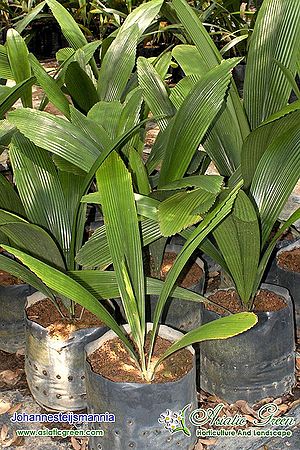Johannesteijsmannia perakensis
| Johannesteijsmannia (yo-hahn-nes-tehs-mahn-EE-ah) perakensis (pehr-ah-KEHN-sis) | |||||||
|---|---|---|---|---|---|---|---|
 J. perakensis in habitat, near Ipoh, (Perak) in NW Peninsular Malaysia. Photo by pilou. | |||||||
| Scientific Classification | |||||||
| |||||||
| Synonyms | |||||||
|
| |||||||
| Native Continent | |||||||
|
| |||||||
| Morphology | |||||||
| |||||||
| Culture | |||||||
|
| |||||||
| Survivability index | |||||||
|
| |||||||
| Common names | |||||||
|
| |||||||
Contents
Habitat and Distribution
Endemic to Ipoh (Perak) in NW Peninsular Malaysia, in low mountainous rainforests. NOTE: Johannesteijsmannia perakensis was previously discovered, recorded and believed only to grow in the State of Perak at the Gunung Bubu, and Kledang Siong Forest Reserves, within the Kledang and Bintang Ranges. The rediscovery of Johannesteijsmannia perakensis in Gunung Bongsu Forest Reserve in Kedah.Description
Johannesteijsmannia perakensis is the only species with a trunk. (Up to 4 m tall.) Solitary palm that can reach heights over 20 feet high, due a long slender trunk that grows to 12 feet in length. The undivided large leathery leaves are the most desirable trait of this palm. They can reach 10 feet long and remain undivided. The overall shape of the undivided leaves can be compared to a elongated diamond. A slow growing palm, the J. perakensis can take upwards to 10 years to develop a viewable trunk. Editing by edric.
Culture
Shady, moist and well drained understory area where it can avoid too much direct sunlight throughout the day. Due to its slow growing nature, it should be planted in a area where other plants will not overtake it throughout the years. The J. perakensis is not cold hardy and should be grown in zones 10-11 only. It cannot handle sub 40 F temperatures well, and should be protected if the temperatures are to drop under 40 F.
Comments and Curiosities
| read more |
|---|
|
Endemic to central Perak, Peninsular Malaysia; recently reported also found in Gunung Bongsu Forest Reserve in Kedah. Johannesteijsmannia perakensis is the only species with a trunk. (Up to 4 m tall.) Solitary palm that can reach heights over 20 feet high, due a long slender trunk that grows to 12 feet in length. The undivided large leathery leaves are the most desirable trait of this palm. They can reach 10 feet long and remain undivided. The overall shape of the undivided leaves can be compared to a elongated diamond. A slow growing palm and can take upwards to 10 years to develop a view-able trunk. Native only to the undergrowth of rainforest on two small hill ranges in the Ipoh area of Perak in northwestern Malaysia, and now in Gunung Bongsu Forest Reserve in Kedah, this spectacular palm is similar to Johannesteijsmannia altifrons but develops a slender aboveground trunk that can reach about 4 m (13 ft.) tall, making it the largest of the genus. Its short inflorescences are produced from among the leaves and carry small, scented flowers that develop into rather large, curiously warty fruits. While in its native range it has been common enough that the very large undivided, diamond-shaped and strongly pleated leaves have been put to the rather profane use of thatching local dwellings, today, like so many palms, it is seriously threatened by the destruction of virgin rainforests without which it cannot regenerate. In cultivation, it is more cool-tolerant than its habitat suggests, and will grow happily in a warm subtropical climate and, of course, anywhere in the tropics, in a shady, wind-protected situation. Because seeds have not been available for propagation, it has remained exceedingly rare though, the most uncommon of the Joey palms, and is seen only in very few collectors gardens around the world. (RPS.com) "There seems to be more J. perakensis available, at least in my neck of the woods (South Florida). It appears quite robust in comparison to J. altifron with initial leaves 8- 10" long. It doesn't mind some bright morning light and filtered light in the PM. Plan on keeping my plants in pots for as long as possible with good drainage and moisture retention mix (perlite, lava rocks and aliflor are good). I understand that they can withstand cold temperatures for brief periods as long as they are protected from wind. Plan to put my plants inside if it gets cold in the winter." (Kiloa) "Beautiful palm, with a stem/trunk, has stiffer undivided and deeply corrugated arching shinier leaves than the other species. From peninsular Malaysia. Very slow palm. Not doable in southern California." (Geoff Stein) |
- IMAGE GALLERY
External Links
References
Phonetic spelling of Latin names by edric.
Special thanks to Geoff Stein, (Palmbob) for his hundreds of photos.
Special thanks to Palmweb.org, Dr. John Dransfield, Dr. Bill Baker & team, for their volumes of information and photos.
Glossary of Palm Terms; Based on the glossary in Dransfield, J., N.W. Uhl, C.B. Asmussen-Lange, W.J. Baker, M.M. Harley & C.E. Lewis. 2008. Genera Palmarum - Evolution and Classification of the Palms. Royal Botanic Gardens, Kew. All images copyright of the artists and photographers (see images for credits).
Many Special Thanks to Ed Vaile for his long hours of tireless editing and numerous contributions.

































































